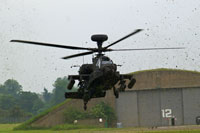|
The UK MoD ordered 67 Apache based on the
US Army AH-64D manufactured by Boeing in 1995. Boeing built the
first eight aircraft, and partially assembled the other 59.
The UK Westland helicopter company undertook final assembly, flight
testing and programme support at their Yeovil factory.
Full operating capability for all three Apache Attack Regiments was
achieved in mid 2007 and in UK service the aircraft is known as the
AH Mk1.
We believe that there are 48 operational aircraft in three
regiments (each of 16 aircraft). The remaining 19 aircraft will be
used for trials, training and a war maintenance reserve (WMR).
The Apache can operate in all weathers, day or night, and can detect,
classify and prioritise up to 256 potential targets at a time. Apart
from the ‘Longbow’ mast-mounted fire control radar, the aircraft is
equipped with a 127 x magnification TV system, 36 x magnification
thermal imaging, and 18 x magnification direct view optics.
The
missile system incorporates Semi-Active Laser and Radio Frequency
versions of the Hellfire missile, whose range is at least 6 kms. Apart
from the Rolls-Royce engines, specific British Army requirements
include a secure communications suite and a Helicopter Integrated
Defensive Aids System (HIDAS). Programme cost is some £3 billion.
It is believed that an air to air
weapon capability will continue to be investigated and trials of the
Shorts Starstreak missile onboard an AH 64 have continued in the US.
Any longer term decision to proceed will be based on the results of
these US Army trials.
|
 |
|
|
The night vision system of 67 Apache AH Mk1 attack helicopters is to
be upgraded. The M-TADS/PNVS, which is designated Arrowhead, is
replacing the existing forward-looking infra-red (FLIR) and daylight
television image intensifier with new sensors to provide improved
target identification over longer ranges, better pilot performance
and reduced life-cycle costs.
The Apache AH Mk 1 presents a completely new capability for the Army
Air Corps with significant implications for Air Manoeuvre Doctrine
in Land and Joint Operations. The Apache certainly gives the British
Army the ‘punch’ necessary for operations during the next decade and
reports from operational areas suggest that the introduction into
service of the Apache AH Mk 1 has been a resounding success.
The
Hellfire anti-tank guided guided missile (ATGW) has a range
approaching 6 kms and is capable of defeating all types of armour.
The missile has a length of 1.78 metres and weighs 43.1 kg.
The
guidance system is semi-active laser homing. These aircraft had a significant effect upon operations during the
1991 Gulf War where the US Army deployed 288 x AH-64 Apache in 15 Army
Aviation battalions.
The US Army claimed that these aircraft destroyed
120 x APCs, 500 x MBT, 120 x artillery guns, 10 radar installations,
10 x helicopters, 30 x air defence units, about 300 soft-skinned
vehicles and 10 x fixed-wing aircraft on the ground.
A single Army Aviation AH-64 battalion is believed to have destroyed
40 x APCs and over 100 x MBT in an engagement that lasted over three
hours, firing 107 Hellfire missiles and over 300 x 70 mm rockets.
|
APACHE (AH MK1) Specifications |
|
67 available |
|
Gross Mission Weight |
7,746kgs (17,077lb) |
|
Cruise Speed |
272km/h at 500m |
|
Maximum Range |
(Internal Fuel with 20 minute reserve) 462kms |
|
General Service Ceiling |
3,505m (11,500ft) |
|
Crew |
2 |
|
Armament |
Carries 16 x Hellfire II missiles (range
6,000m approx)
76 x 2.75"
rockets
1,200
x 30mm cannon rounds
4
x Air-to-Air-Missiles
|
|
Engines |
2 x Rolls Royce RTM-332 |
Photos Copyright
Alasdair Taylor
|